
Anna Walinska (American, 1906-1997)
Refugees, 1957
Oil on canvas, 41 H. x 33 W. inches
Signed lower right: Walinska

Anna Walinska (American, 1906-1997)
Three Musicians, 1952
Gouache on paper
24 H. x 18 ⅞ W. inches
Signed lower left: Walinska ’52



Anna Walinska (American, 1906-1997)
Embrace #1, 1984
Watercolor and gouache on Burmese Shan paper
22 ¼ H. x 24 W. inches
Signed lower left: Walinska ’84

Anna Walinska (American, 1906-1997)
Two Women, 1960
Ink on canvas
14 ½ H. x 8 W. inches
Signed lower left: Walinska

Anna Walinska (American, 1906-1997)
Patriarch, 1944
Oil on canvas, 30 H. x 24 ½ W. inches
Signed lower left: Walinska
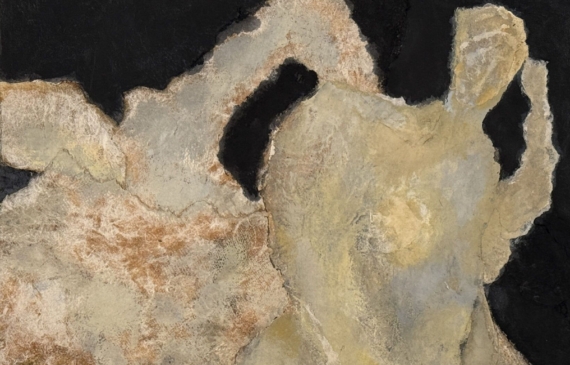
Anna Walinska (American, 1906-1997)
Figures, 1960
Collage: Burmese Shan paper,
oil paint, and gouache on paper
22 ½ H. x 21 ¾ W. inches

Anna Walinska (American, 1906-1997)
Figures in Landscape (Holocaust Series), 1954
Oil on paper
22 H. x 16 W. inches
Signed lower right: Walinska


Anna Walinska (American, 1906-1997)
Nevelson, 1975
Oil on board, 10 ¼ H. x 11 ¾ W. inches
Signed lower left: Walinska ‘75
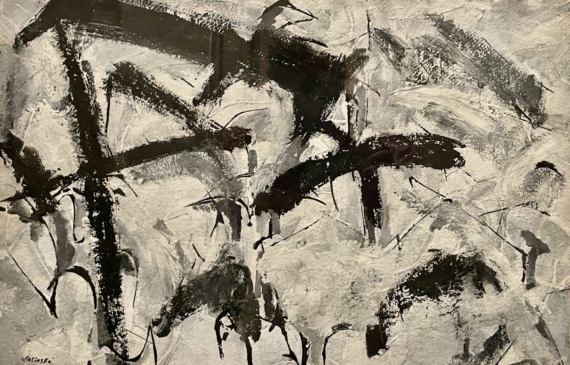

Anna Walinska (American, 1906-1997)
Tokyo Landscape, 1957
Oil on paper, 13 ½ H. x 20 W. inches
Signed lower left: Walinska

Anna Walinska (American, 1906-1997)
Figures in Landscape – The Lake, c. 1955
Oil applied with palette knife on paper
8 ⅜ H. x 9 W. inches

Anna Walinska (1906-1997)
Wharf, c. 1955
Oil with palette knife on paper
4 ¼ H. x 5 ½ W. inches
Signed lower left: Walinska



Anna Walinska (American, 1906-1997)
Figure, 1957
Oil applied with palette knife on paper
6 ¾ H. x 8 ¾ W. inches
Signed lower left: Walinska

Anna Walinska (American, 1906-1997)
Figures, 1961
Burmese Shan paper collage with oil
36 H. x 24 ½ W. inches
Signed center and verso
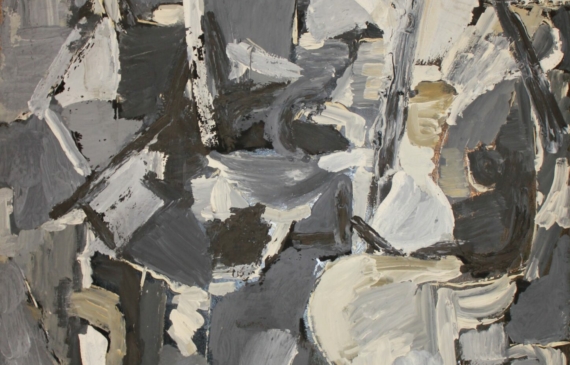
Anna Walinska (American, 1906-1997)
Figures in Landscape, 1956
Casein on board
24 H. x 18 W. inches
Signed lower left: Walinska ‘56



Anna Walinska (American, 1906-1997)
Night Flight, 1961
Collage: Burmese Shan paper and oil on burlap
12 ¼ H. x 16 ¼ W. inches
Signed lower right: Walinska ‘60



Anna Walinska (American, 1906-1997)
Kabuki, 1960
Collage: Burmese Shan paper and acrylic paint on paper
31 H. x 25 ¾ W. inches
Signed lower left: Walinska ’60



Anna Walinska (American, 1906-1997)
The Earth Bears Witness
– Burma Landscape with Figures, 1956
Casein and oil on toned paper, 36 H. x 24 W. inches
Signed lower right: Walinska ‘56


Anna Walinska (American, 1906-1997)
Miss Ichiku, 1955
Collage: Magazine paper and watercolor on paper
13 ¾ H. x 11 W. inches
Signed lower right: Walinska ‘55

Anna Walinska (American, 1906-1997)
Figures in Landscape, 1951
Casein on paper
24 H. x 36 W. inches
Signed lower right: Walinska ‘51

Anna Walinska (American, 1906-1997)
Figures in Landscape – Adam & Eve, 1953
Casein on paper
36 H. x 24 W. inches
Signed lower right: Walinska ‘53

Anna Walinska (American, 1906-1997)
Figures in Landscape, 1960
Burmese Shan paper collage with oil on paper
6 H. x 4 W. inches
Signed and dated lower right:
Walinska ’60

Anna Walinska (American, 1906-1997)
Burma Landscape, 1956
Collage: Burmese Shan paper, oil, and gouache on canvas
20 H. x 24 W. inches
Signed lower left: Walinska ‘56
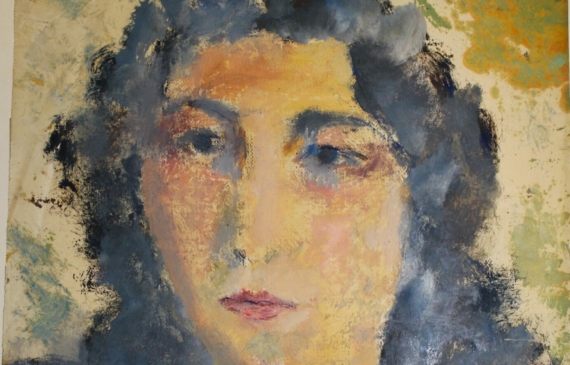
Anna Walinska (American, 1906-1997)
Self-Portrait, 1927
Oil on paper
14 ¼ H. x 10 W. inches
Signed lower left: Walinska ‘27

Anna Walinska (American, 1906-1997)
Figures in Landscape, c. 1954
Oil on paper
26 ½ H. x 14 W. inches
Signed lower right: Walinska


Anna Walinska (American, 1906-1997)
The Hanged, 1982
Collage: Burmese Shan paper and watercolor on brown paper
25 ½ H. x 19 ¾ W. inches
Signed lower right: Walinska ‘82



Anna Walinska (American, 1906-1997)
Kabuki, 1956
Oil and casein on artist board
15 ¾ H. x 11 ¾ W. inches
Signed upper right: Walinska ‘56

Anna Walinska (American, 1906-1997)
Study of Nevelson #2, 1963
Charcoal on board, 8 H. x 5 W. inches
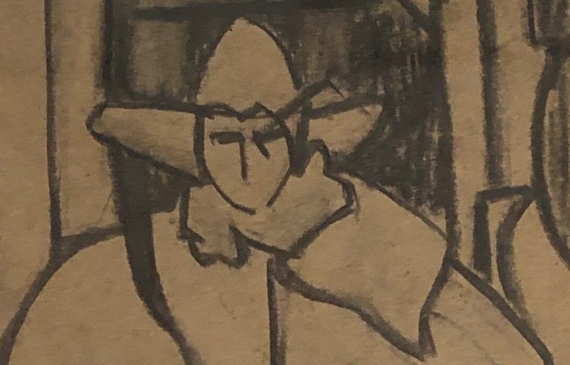
Anna Walinska (American, 1906-1997)
Study of Nevelson #1, 1963
Charcoal on board, 8 H. x 5 W. inches

Anna Walinska (American, 1906-1997)
Paris Nude #53, 1929
Ink on paper
8 ½ H. x 11 W. inches
Signed lower right: Walinska ’29

Anna Walinska (American, 1906-1997)
Paris Nude #39, 1929
Ink on paper
8 ½ H. x 11 W. inches
Signed lower right: AW. ’29

Anna Walinska (American, 1906-1997)
Paris Nude #57, 1929
Ink on paper
11 H. x 8 ½ W. inches
Signed lower right: Walinska ’29

Anna Walinska (American, 1906-1997)
Paris Nude #116, 1928
Ink on paper
11 H. x 8 ½ W. inches
Signed lower right: Walinska ’28

Anna Walinska (American, 1906-1997)
Paris Nude #32, 1928
Ink on paper
11 H. x 8 ½ W. inches
Signed lower left: Walinska ’28

Anna Walinska (American, 1906-1997)
Paris Nude #41, 1929
Ink on paper
8 ½ H. x 11 W. inches
Signed lower right: AW. ’29


Anna Walinska (American, 1906-1997)
Musicians in Landscape – The Boatmen, 1957
Gouache and watercolor on paper
20 H. x 25 ⅞ W. inches
Signed lower left: Walinska ‘57

Anna Walinska (American, 1906-1997)
Dancers, 1956
Oil on paper
12 H. x 18 W. inches
Signed lower right: Walinska ’56
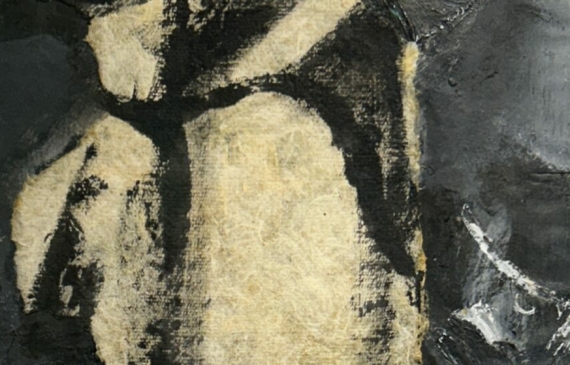
Anna Walinska (American, 1906-1997)
Figures in Landscape, c. 1961
Burmese Shan paper collage with oil
16 ½ H. x 10 ¾ W. inches
Signed lower right on matte
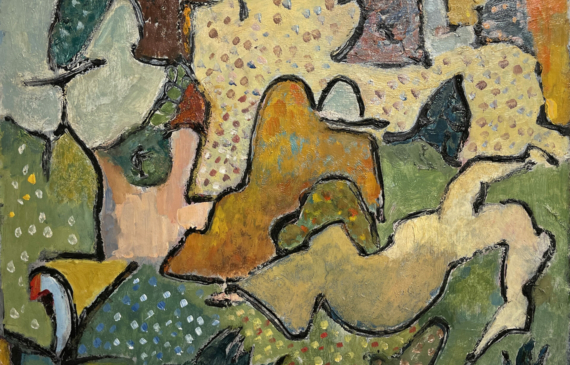
Anna Walinska (American, 1906-1997)
The Picnic, 1947
Oil on board, 16 H. x 20 W. inches
Signed lower left: Walinska ’47

Anna Walinska (American, 1906-1997)
Sacrifice of Isaac #1, 1955
Ink on paper
44 ¾ H. x 20 ¾ W. inches
Signed lower right: Walinska ’55

Anna Walinska (American, 1906-1997)
Self-Portrait, c. 1928
Oil on unstretched canvas
6 H. x 5 W. inches
Framed: 9 ¼ H. x 8 ¼ W. inches


Anna Walinska (American, 1906-1997)
Survivors, c. 1980
Oil on printed photo paper
13 ¾ H. x 13 ½ W. inches

Anna Walinska (American, 1906-1997)
Paris Nude #37, 1929
Ink on paper
11 H. x 8 ½ W. inches
Signed lower left: Walinska ’29

Anna Walinska (American, 1906-1997)
Paris Nude #33, 1929
Ink on paper
8 ½ H. x 11 W. inches
Signed lower left: Walinska ’29

Anna Walinska (American, 1906-1997)
Paris Nude #74, 1929
Ink on paper
8 ½ H. x 11 W. inches
Signed lower right: Walinska ’29
A woman ahead of her time, Anna Walinska never let contemporary attitudes stand in the way of artistic expression. A Jewess born in London to Russian activist parents in 1906, moving to Brooklyn in 1914, Walinska was destined to lead an unconventional life. She enrolled at the National Academy of Design to study painting at just 12 years old, moving from there to the Art Students League. Her oldest dated watercolor is from 1918, evincing a raw talent full of potential. Despite her father’s objections, the young artist was determined to study in Paris and secured funding from her father’s employer by offering to paint him a copy of a masterpiece in exchange for $2,000. She set out in 1926, taking up residence on the Left Bank at 67 Rue Madame, just around the corner from Gertrude Stein.
While in Paris, she studied under André Lhote, took classes at the Grand Chaumiere, and sketched daily at the Académie Colarossi. Many artists living in the city flocked towards one another, but Walinska instead found herself keeping the company of musicians and composers, including Arnold Schoenberg and Francis Poulenc. She even screen tested for Gaumont’s Joan of Arc film, where she would meet the legendary Josephine Baker, another daring woman whose prowess undoubtedly encouraged Walinska.
The influence of Picasso and Matisse on the young artist’s work is apparent; while Walinska avoids being derivative of these masters, concepts prominent in their respective practices appear in her work, especially those created between the late ‘20s and ‘30s. Paris was the first place the artist was able to take a nude figure drawing class complete with live models, something she had dreamed of for years. She produced hundreds of line drawings, delicately capturing her subject’s form in visceral, unplanned sketches that hint at the artist’s natural grasp on composition. Walinska arguably would have been a champion of the body positivity movement today – beyond her admiration of the human form, she unabashedly painted nude self portraits and modeled for other artists
Returning to New York around 1930, Walinska gained employment as a curator with the WPA and opened her own gallery, the Guild Art Gallery (whose records can be found in the Smithsonian’s Archives of American Art today). She was determined to bring French sensibilities to the Manhattan art world, giving Arshile Gorky his first solo show and exhibiting artists like Chaim Gross, Raphael Soyer, and Theodore Roszak. In 1937, her own work was featured at the 1st Annual Members Exhibition for the American Artists’ Congress, and was chosen as the Assistant Creative Director of the Contemporary Art Pavilion at the 1939 World’s Fair.
People and places Walinska encountered in her own life were increasingly featured as the subjects of her work, whether abstract or figurative. Landscapes, cities, musicians, family members, dancers, and fellow artists were all integrated into her paintings and collages, adding a personal quality to her portfolio. Her young sister Emily served as a muse, sitting for numerous portraits in different styles as a child and an adult. Walinska saw growing success when featured in the 1942 Artists for Victory exhibition at the Metropolitan Museum of Art and Paintings of the Year at the National Academy of Design, 1946. She did not limit herself to the visual arts, however, and explored her creative side by appearing in Yiddish theater and performing with a Flamenco dance troupe.
From 1954-1955, Walinska spent six months traveling across Asia into Europe, sojourning in Burma for four of those months. While there, she stayed with her brother, who was working as an economic advisor to Burma’s Prime Minister, U Nu, affording her the chance to capture the nation’s leader in a number of portraits. “I lived a full year in those four months,” Walinska said, explaining the impact of her time in Burma. “It was a remarkable experience for me socially as well as culturally. I came back from Rangoon very much enriched. I painted for years under the influence of Burma.” During her stint in the country, she taught craftsmen how to construct easels and stretch canvas; local artists showed her the best places to paint en plein air and in exchange she shared her knowledge of the commercial art world. It was here that she was introduced to Burmese Shan paper, a material she adored and subsequently incorporated into her practice. Indeed, while she did travel to many other countries, her experiences in Burma continued to inform her work for many years. Upon departing New York City for her grand escapade, she traveled to Honolulu, Tokyo, Hong Kong, Bangkok, Burma, New Delhi, Karachi, Cyprus, Israel, Istanbul, Athens, Rome, Perugia, Florence, Venice, Pompei, Naples, Sorrento, Capri, Nice, Barcelona, Madrid, Toledo, Lisbon, and finally to Bermuda.
Constantly exhibiting, Walinska’s work was featured in Recent Drawings USA, Museum of Modern Art, 1956; Baltimore Museum of Art, 1957; and numerous exhibitions organized by the American Federation of Modern Painters & Sculptors and the National Association of Women Artists. Notably, she was awarded a retrospective at the Jewish Museum in 1957. This was the first time her series about the Holocaust was exhibited, as the works preceded the existence of museums dedicated to victims of the atrocity. 93 pieces from this series were exhibited at her later retrospective in 1979 at the Museum of Religious Art at the Cathedral of St. John the Divine.
Walinska exhibited alongside important contemporaries like Fernando Botero, Wilfredo Lam, Louise Nevelson, and Jasper Johns. Her portraits of prominent artists of the New York School can be found in major museum collections, including those of Gorky in the Smithsonian American Art Museum and the Johnson Museum at Cornell, drawings of Mark Rothko in the National Portrait Gallery and the Magnes Museum in Berkeley, and portraits of Louise Nevelson in both the National Museum of Women in the Arts and the Magnes. She also worked as a teaching artist in residence at the Riverside Museum, where she showed 16 times before the collection merged with the Rose Art Museum at Brandeis University in 1971.
Collage and spray paint worked their way into the artist’s arsenal over time, allowing for greater experimentation with materials. Never hesitant to pursue her interests, Walinska even ventured into erotic art in her later years, creating captivating work inspired by the Japanese Shunga tradition. Despite her ardor for life and obvious artistic aptitude, like many women artists, she has mostly been omitted from art history canon. She was on the verge of being “discovered” when she was preparing for her trip to Burma – Guggenheim Museum director James Johnson Sweeney sent her a letter stating that he was impressed with her work and wanted to visit her studio. She called this “the greatest moral encouragement I have ever had,” but was consumed with the desire to explore and translate her experiences into art, ultimately passing up Sweeney’s offer and embarking on her international journey.
Walinska only married briefly and never had any children, choosing to devote her life to art, music, dance and theater; forging meaningful relationships with nieces and nephews; and seeing more of the world than many of us will today, in a digital age that has made travel exponentially more accessible. Rather than fearing the unknown, Walinska jumped in head first, seeking to learn, experience, and grow through all of her endeavors. Her work is housed in the collections of renowned institutions like the Baltimore Museum of Art; Denver Art Museum; Yad Vashem, Jerusalem; Jewish Museum, New York; Tel Aviv Museum of Art; National Museum of American Art, Washington, DC; National Museum of Women in the Arts, Washington, DC; Phillips Collection, Washington, DC; and the Hudson River Museum, Yonkers.